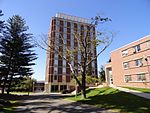The Apiary Laboratory, more often referred to as the Apiary, is a research laboratory at the University of Massachusetts Amherst. Originally built for the study of honey bees and apiculture, today it is primarily used to study native pollinator species and the chemicals and pathogens impacting their populations. This academic building is unique in that it is credited as being the first in the United States to be erected exclusively for the teaching of beekeeping.Prior to the construction of the building, the Massachusetts Agricultural College had maintained a beekeeping program for a number of years as one of the first land-grant agricultural colleges to teach the subject in the United States. In time, techniques in apiculture progressed, leaving beekeeping as no longer simply a hobby, but rather a viable agricultural business. The college's program had remained limited to a single short-course for a number of years but was expanded however, when in 1911, a bill passed establishing the office of "state apiary inspector". Dr. Burton N. Gates, the man first appointed to this position was also the college beekeeping lecturer at the time, and would oversee the expansion of the program as an asset to the college and a service to the state in the years to come. Construction began on the apiary in February 1911 and with its completion in June of the following year for a total cost of $3000. At the time the building contained a laboratory, a wintering cellar, a wood workshop, an office with a comprehensive library of apicultural books, honey and wax extraction rooms and a two-person apartment used by student tenants. It was also the first structure built in the college orchard, a section of campus now known as the Central housing area.In the time that Gates was there, research focused mainly on honey production, brood diseases, wax extraction and horticultural pollination in the cucumber and cranberry industries. From 1913 to 1920 the laboratory was also operated by a superintendent, John L. Byard, hired on by Gates to maintain the facilities from day to day as well as perform wax extractions and other services to beekeepers from around the state. Following Gates' resignation in 1918, the school ceased to offer its summer beekeeping school, many of its state extension services, and the college went through several different professors before hiring Frank R. Shaw as the new professor of beekeeping in 1931. With Shaw's retirement in 1969, the laboratory was rededicated to urban and medical entomology research, with the former beekeeping program falling into relative obscurity.At the present time the apiary is used exclusively for research on native pollinator decline and ecology, with the last beekeeping classes taught at the university nearly a decade ago. The building is currently on the university's "defer and do not reinvest list", suggesting that it will ultimately be dismantled at some point in the near future.








